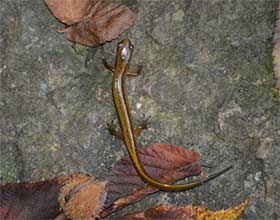 There’s no more relaxing way to spend a summer day than creekin’. Wander down a local creek and you’re sure to scare up a variety of critters: minnows and darters swim off to undisturbed waters, crayfish skitter under the nearest stone ledge, and the occasional water snake glides out of view. Other inhabitants require just a bit more effort to reveal. But turn over stones along the creek’s edge and it won’t be long before a skinny, shiny, yellowish little animal wriggles off to its next hiding place. You’ve found a southern two-lined salamander, Eurycea cirrigera!
There’s no more relaxing way to spend a summer day than creekin’. Wander down a local creek and you’re sure to scare up a variety of critters: minnows and darters swim off to undisturbed waters, crayfish skitter under the nearest stone ledge, and the occasional water snake glides out of view. Other inhabitants require just a bit more effort to reveal. But turn over stones along the creek’s edge and it won’t be long before a skinny, shiny, yellowish little animal wriggles off to its next hiding place. You’ve found a southern two-lined salamander, Eurycea cirrigera!
Salamanders constitute an order of amphibians, the Urodela. In general, they have a readily recognizable body form: long and skinny, with moist skin and a squat four-legged posture. Eurycea salamanders exemplify, and even exaggerate, that shape. They are particularly skinny, and they have particularly dainty legs.
Two-lined salamanders are streamside residents. They lay their eggs in the water and hatch into aquatic larvae, similar to frogs developing from tadpoles. (Some plethodontid species are more terrestrial and skip the larval stage, instead hatching out directly as miniature adults.) While living under water, the larvae “breathe” (acquire oxygen) using two body surfaces. First, they have permeable skin that allows oxygen to enter their body from the surrounding water. And second, they have frilly external gills, which provide additional surface area for oxygen uptake.
The transition from aquatic larva to adult salamander includes several changes that facilitate a partially terrestrial existence, as the name “amphi-bian” (“double life”) implies. Some of those changes relate to locomotion on land; salamander larvae already have dainty legs, but they do lose their tail fin. Other changes facilitate terrestrial respiration. External gills do not function well in the air, and so the gills disappear. In most amphibians, an alternative set of breathing organs—the lungs—develop instead, providing a moist internal surface for acquiring oxygen. But two-lined salamanders and other members of their salamander family—the Plethodontidae—are an exception to that pattern. When plethodontids metamorphose to adulthood, their external gills do disappear, but they do not develop lungs. Indeed, the common name for plethodontids is the “lungless salamanders.”
How do two-lined salamanders get by without lungs? Plethodontids still need to acquire oxygen to support their metabolism, but in the absence of gills and lungs their only respiratory surface is the external skin. Despite that, two characteristics of plethodontids allow oxygen supply to meet demand.
First, two-lined salamanders have relatively low body temperatures (as residents of cool creeks) and quiet lifestyles. The resulting slow rates of metabolism generate low demand for oxygen. Second, their long, skinny shape means that plethodontids have a lot of body surface area (the site of oxygen uptake into the body) relative to their body mass (the volume of tissues that require oxygen). That high ratio of surface area to body volume facilitates an adequate match between oxygen uptake and demand.
Still, the skin is a less effective surface for acquiring oxygen than the gills or lungs, and so the absence of lungs does constrain the animal. Lungless salamanders can increase their rates of oxygen use just half as much as salamanders with lungs. As a result, they have limited capacity for exercise. Maximal rates of oxygen use occur at speeds just 10 – 50% of those achieved by salamanders with lungs, and lungless animals also fatigue much more quickly. Presumably, those relatively sluggish capacities are adequate for catching prey (a variety of aquatic invertebrates) and for their mostly quiet lifestyles. Two-lined salamanders still can put on a quick, short-term burst of activity if need be, using muscle metabolism that doesn’t require oxygen delivery (like a sprint vs. a jog). They can be surprisingly quick and wiggly!
Plethodontids have one additional survival strategy that helps them in the event of attack by a predator. Along with salamanders in a couple other families, plethodontid are able to regrow lost appendages, including both limbs and tails. Amazingly, the regenerated organs have full, normal skeleton and muscles. That ability derives from the activity of stem cells that can develop into a wide variety of cell types. Some lizards, which lack such fully functional stem cells, also can regrow tails, but not with the full suite of original structures.
With that capability in their toolkit, two-lined salamanders will sometimes self-release (“autotomize”) their tail if they are attacked. The base of the tail has specialized weak points in the skin, muscles, connective tissue, and skeleton that define the point of breakage. When the tail is lost, a cylinder of skin folds over the break point to stimulate clotting and enclose the wound. The disconnected tail segment wiggles in a way that attracts the attention of the predator, while the salamander itself sneaks off to live another day. In a few months, the salamander will have a tail as good as the original. But it still won’t have lungs!
Article and photo contributed by Dr. David L. Goldstein, Emeritus Professor, Department of Biological Sciences, Wright State University.
